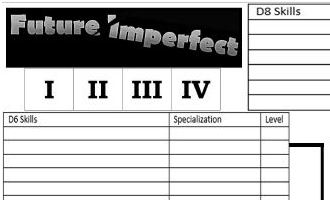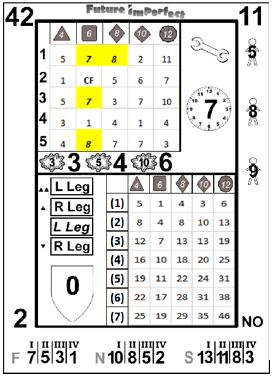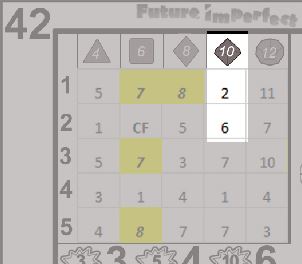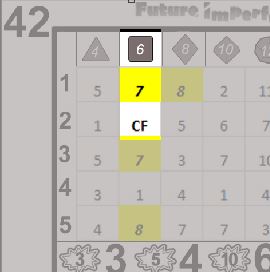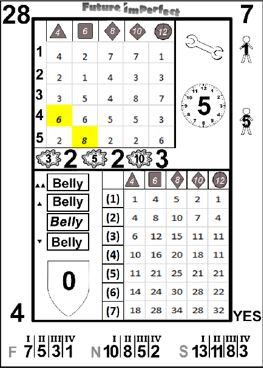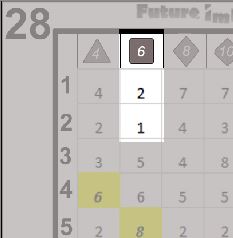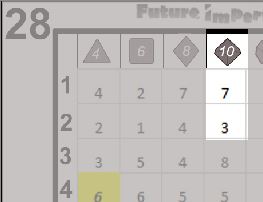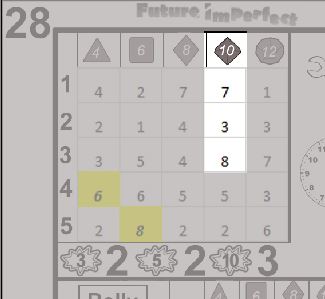The West That Wasnt - Initiative And Action Speeds
When the game enters action time, speed and order of operations become vitally important. The initiative system below describes how to use action speeds to determine action sequence.
Contents
Action Time vs Narrative Time
Past Participle differentiates between action time and narrative time in the following manner. Narrative time is any time during the game when detailed timekeeping and movement is unnecessary. In narrative time, the passage of a few minutes, or even an hour or more, can be assumed to occur as necessary. It is likewise unnecessary to know the detailed moment to moment location of characters and NPCs.
The most common usage for action time is combat, but it is also used for any encounter where time and relative placement of characters is crucial. In these situations, the order of operations has an immediate impact on the game world and the actions that follow.
Action Speeds
Past Participle classifies actions in one of three speed categories: Fast, Normal, and Slow. Action speeds are used to determine the order of actions each round. The action speed determines the target number (TN) for an action to occur, based on the round phase. In other words, faster actions have lower target numbers, and are therefore more likely to occur in the early phases (I-II), versus the later ones (III-IV).
Example Action Speeds
The following list provides the speed of the most common. The list is not exhaustive, but it does cover most situations. The Master is the final authority regarding the speed of any action that is not listed here.
Fast Actions
Run
Some martial arts attacks
Fast weapons such as pistols and knives
Cocking and readying of some weapons.
Reloading cartridge weapons.
Normal Actions
Brawl
Move/Athletics
Weapons such as swords and carbines
Skill use
Ready item
Reload bow
Slow Actions
Extended action. Extended actions are complex skill checks requiring multiple victories to complete, or any other task that may take longer than one round.
Loading muzzle loading weapons and complex breech loaders.
Special Cases
Use item - by item
Aimed shot - depends on weapon type (listed on gear page).
Example item speeds:
The previous image shows the traits for pistols. The SPD column is the action speed of the weapon (followed by the speed to cock/ready), while the Aim column lists the speed of an aim action.
Determining Speed
During combat, characters perform actions in response to a changing environment and situation. The range of possible actions is unlimited, so Past Participle organizes the most common combat actions into 4 types for simplicity. These types are engage, maneuver, assault and auxiliary. The type need not be declared, it is presented to illustrate how to determine speeds of the most common combat actions.
In the action descriptions that follow, passive checks (such as awareness) are separate from other skill checks. See the skills section for a description of passive checks.
Free Actions
Some actions are so quick or simple that they are determined to be free. Each character may do one free action per round in addition to any other actions. Any further free actions count as a fast action and must be combined as described below. Some examples of free actions are talking (a sentence or two), giving a hand signal, or dropping an item.
Engage
A character performing an engage is using a movement action as well as performing an attack action. Engaging characters may use attacks of any speed. Aim counts as an attack action for this purpose. Slow weapons may not be used with an engage action. Engaging characters may not perform skill checks except for fast draw/rapid reload. Speed for an engage is one level slower than the slowest action being performed.
Maneuver
Maneuver is any combat action consisting solely of movement action(s). Any combination of movement types is allowed. When using maneuver, any speed can be declared. Recall that when the character acts, he may perform any action that is the declared speed or faster. This means that if a fast action is declared, the character will be considered to run when they move, even if they move only within their normal move distance (because they are rushing). Maneuvering characters may not perform skill checks except for fast draw/rapid reload. Characters who run may choose a Fast action, other types of movement are Normal or Slow.
Assault
A character performing an assault is exclusively utilizing attack and/or defense actions. Assaulting characters may use attacks of any speed, and aim counts as an attack action for this purpose. Slow weapons may only make aimed attacks if they were aimed the previous round. Assaulting characters may not perform skill checks except for fast draw/rapid reload. Assault actions use the speed of the weapon/attack, unless combined with an aim/cock. In that case, the speed is one slower than the slowest of the actions.
Auxiliary
When performing an auxiliary action a character may make no attacks. They may perform any other skill checks as needed. A character performing an auxiliary action can either be focused or cautious. Focused characters sacrifice their defense (the TN to hit them is reduced by 2), but perform their skill checks normally. Cautious characters do not suffer defensive penalties, but their skill checks are at -2, and complex actions increase victories required by 1 (except when reloading). Auxiliary actions are slow (they may be "hurried", see skills section).
Combining Actions
The previous sections described how to determine the speed of a character performing one action, or a defined group of actions, in an action type. If a character wishes to combine additional actions, the declared speed must be adjusted. Also, the extra actions must be allowed by the chosen class. Some further action combination limitations:
1. A Slow action may never be combined with any other action.
2. No more than three actions may be combined in a round (plus up to one free action, as above).
When combining actions, the resulting speed is one slower than the slowest action in the group.
Examples
Reuben McRotch wishes to load his '58 Springfield musket, which is a slow action. This may not be combined with any other action. He declares a slow action.
Miranda Valentine plans on running (fast) and firing her Peacemaker (fast). She declares a Normal speed action.
Jonah Benton wishes to run (Fast), fire a Peacemaker (Fast) and draw his knife (Normal). He is attempting three actions (the maximum), and the slowest among them is normal, therefore, he declares a speed of slow.
Initiative
What follows is a description of how to sequence action rounds.
Overview
The sequence works as follows.
I. Declare.
A. Characters declare speed of intended action.
II. Resolve.
A. Flip card(s) and determine Reflex results for all characters.
B. Determine phase for each character.
III. Act
A. Starting in Phase I, characters act in Reflex order.
Phases and Round Timing
Each action round is divided into four phases (I-IV). All actions in the first phase occur before any actions in the second phase. Within each phase actions occur in descending order based on Reflex die (first type, then number). Further ties are broken in favor of the Crew, or Master discretion, in that order.
After all four phases have resolved the round is over, and if necessary a new one is begun.
Determining Initiative
The initiative system involves two steps: declaration and resolution. During the declaration phase, players take turns indicating the speed their character will be acting during this round. After all characters have declared, a card is drawn to resolve the initiative order.
Declaration
At the beginning of the round, all characters that are participating in the action declare their intentions. Each character declares in turn. Normally, the order of declarations is unimportant, however, if the Crew wishes declarations can be ordered in ascending Reflex order. Players should not be allowed to change their action speed declaration in response to another declaration (though normally it should not matter, as previously stated), but this can be allowed with Master discretion.
It is recommended that each player have a counter for each speed: Fast, Normal and Slow. This way, everyone can select their speed token and reveal simultaneously.
When making a declaration, the player indicates the speed of the action they wish to perform this round. No more specificity is required. The goal of the declaration is to define how quickly a character is acting during the round, not to force a decision before the situation has an opportunity to unfold. When their turn arrives, they may choose any action that has the declared speed or higher.
Action Type
Earlier in the chapter the concept of action type was described. The type of the action is used to help determine the correct speed for the action(s) the character will do during the turn. In most cases the action type does not need to be discussed. It can be relevant when performing an auxiliary action, because of the effect on defense. It is never necessary to declare your action type for initiative determination.
Examples
Reuben wishes to fire at one of the LaRue posse that is surrounding him. His double action Peacemaker has an action speed of normal. He declares a normal speed action. He does not need to declare a target. When it is his turn to act, he can choose any target he wishes. He may also choose to do any action that has a higher action speed, such as running away (fast action) or yelling to his compatriots (free action).
Jonah is moving along a corridor and has declared a normal speed action. Before he acts, Angus LaRue appears in the doorway in front of him. On his action, he may continue moving (maneuver, Normal speed) or fire with his Peacemaker (assault, Fast speed). He may even do both (engage, Normal speed if he runs, Slow if he does not). But he may not SOME EXAMPLE OF SKILL USE (auxiliary, Slow speed).
Resolution
Once all characters have declared their speed for the round, flip a card and determine the initiative sequence. Each action card has an initiative bar on the bottom edge.
The initiative bar is structured like a table, with the action speed on the left, the TN to the right arranged in columns headed by the appropriate action phase (I-IV). There is a separate table for each action speed (fast, normal and slow). The table tells the TN required to act in that phase with an action of that speed.
To determine when the action occurs, use the cause grid to check Reflexes (see Future_Imperfect_-_Action_Cards#Performing_Skill_and_Attribute_Checks for instructions). Compare the result to the given TN. The character can choose to act in any phase where their Reflex check meets or exceeds the TN (but only one of them, that choice is made now). In the given table, a fast action would resolve in phase I on a 7+, phase II on a 5+, phase III on a 3+ and phase IV on a 1+. If it were instead a slow action the TNs would be 13, 11, 8, 3 respectively. Once a character knows which phase they will act, place the initiative declaration counter on the given phase on their combat reference aid, located on the reverse of the character sheet (or otherwise note the phase).
If a character does not generate a TN high enough to go in phase 4, the character hesitates and does not go this round. Next round his action is considered one speed category faster, with a maximum speed of fast. If the Reflex result is CF, the character does not act this round, and gets no bonus to speed next round. He is also considered to hesitate.
Optional Resolution System
The system uses a single card flip for all participants. It is relatively simple and fast this way. However, it is entirely feasible that your Crew could choose to use one card per side, or even one card per character (or henchman group). The system works exactly the same in either instance.
Taking Actions
Once all characters have determined in which phase they will act, the round begins in phase 1. The Master calls out the phase, beginning with 1, and all characters who will go in that phase indicate such. If there are multiple characters going in a phase, ties are broken based on Reflex, in favor of larger dice, then number of dice. Ties that persist are broken in favor of the Crew. Ties between NPCs are broken by the Master. If no characters act in a phase it can be skipped.
When a character has an action, they may perform any action they choose as long as the action speed of the given action is equal to or faster than the speed they declared. This allows characters to react to a changing scene, while still needing to use planning and strategy during the declaration phase.
Repeat the process for phases 2-4. Once they are complete, the round ends. If another round is necessary, start again from the declarations.
Delaying an Action
Sometimes a character will be ready to perform an action, but the situation is not yet appropriate for one reason or another. In this case, that character may delay their action. If the phase/Reflex when a character is slated to act arrives, and they wish to delay instead, there are two choices: they may declare they are waiting for a specific set of circumstances, or they may declare they wish to wait until a later time to act.
If they declare a set of circumstances the round continues to the next character. As soon as the given circumstance occurs, they may immediately take their action. If the circumstance involves another character or characters, a Reflex contest is resolved between the characters to determine who acts first. In case of a tie the actions are simultaneous.
If the circumstance has still not occurred by the end of the round the character may state they are continuing to wait for the circumstance. This counts as a fast action for determining readiness in the new round, but as the speed of the initial action for all other purposes. If at any time the character wishes to stop waiting for the circumstance they may announce their intent before any action. In this case, they may perform an action after the current action, following all appropriate rules to do so.
If a character wishes to delay until later without declaring a circumstance, they may announce their intent to perform an action at any time after another action completes. If they wish to attempt to preempt another action, a Reflex contest must be resolved with the interrupting character suffering a -2 penalty. If they win, they may go first. Otherwise, they go after the triggering action completes.
Examples
Miranda is certain that the hombre that kidnapped Jonah is going to be coming around the corner at the end of the hall any moment now, so she declares a fast action. Her Reflex check produces an 8, so she goes in Phase I. No one has appeared by the time her action comes, so she declares to the Master that she will fire at the cowboy as soon as he is visible. During Phase III a cowboy attempts to dart across the hall into an open door. Since Miranda had declared she was waiting for this, she engages in a Reflex contest with the cowboy to see if she can fire on him before he enters the open door.
Jonah is being pursued by Angus and one of his flunkies after he has escaped the cell in his hacienda. His only chance to escape is to make it to the livery and hope that Miranda is waiting for him there, with their horses. To be continued
Initiative Example, Jonah Benton Runs From the Perkins Brothers
Jonah is attempting to escape from the Perkins brothers, armed with Bowie knives, after he won a bit too much cash for their liking at an evening poker game. The brothers declare they will attempt a fast action. Jonah also declares a fast action.
The initiative card is drawn.
Jonah gets 6.
According to the initiative table, fast actions require a 7 to go in phase I, a 5 to go in II or later. He chooses to go in phase II (his generated result, 6, is at least 5, for phase II, but less than 7, for phase I). He could have chosen II, III or IV.
Luckily for him, the brothers get CF. Even though the 1-6 result is an exceptional result, because the 2-6 cell is CF they must choose CF. See Future_Imperfect_-_Action_Cards#Critical_Failures for more on critical failures and exceptional results.
When the Master calls out phase II, Jonah indicates he will run around the corner (a fast action). Because the brothers got a CF result, they hesitate and do nothing this round. Clearly the brothers do not have what it takes to handle Jonah, at the card table or outside the saloon.
Initiative Example 2, Miranda and Reuben Square Off Against the LaRue posse
While making their escape from the hacienda cell where Angus had incarcerated them, Miranda and Reuben were spotted by a sentry, and a handful of vaqueros close in on their location.
Miranda and Reuben know they have been spotted, and they surmise hombres are approaching, but they are unsure of how many, and from which direction they will come. In fact, they know precious little about the danger ahead. From their position behind cover, the two weigh options for a moment before the Master asks for declarations.
The Reflex scores of the participants are as follows:
Reuben: 2d6
Miranda: 3d10
Hombre 1: 2d10
Hombre 2: 2d10
Hombre 3: 2d10
The declarations are as follows:
Reuben is armed with a double barreled shotgun he picked up from inside the ranch house, speed normal. He intends to hold the line here, and give Miranda a chance to run for it. His declaration is normal speed action.
Hombre 1 declares a normal speed action. Unbeknownst to the Crew, he is armed with a lasso. He intends to prevent Reuben from firing on his comrades (and himself).
Hombre 2 declares a fast action. Also unknown is that this operative is armed with a heavy club, he intends to close the distance on Miranda, so that next round he can easily stun her (very ungentlemanly, this hombre). Running is a fast action.
Hombre 3 declares a normal action. He is the backup plan, in case either or both of his partners fail. He is armed with a .44 Army single action revolver, cocked. The pistol is a fast action, but he wishes to see how their plan progresses before acting. He may choose to move, or fire, but since Angus wants these two alive if possible, firing is a last resort. Since he declared a normal action, he may freely use a fast action as well.
Miranda declares a fast action, but she has no intention of leaving Reuben here on his own. She plans on using her Peacemakers to clear the field so that she and Reuben can make their escape together.
A card is drawn (28):
REuben has 2d6 Reflexes, so he gets a 2.
Since he declared a normal speed action, he goes in phase IV.
The Hombres have 2d10 Reflexes, so they get 7.
Hombres 1 and 3 declared normal speed actions, so they also go in phase III, because 7 is greater than or equal to 5 but less than 8.
Hombre 2 declared a fast action, so he goes in phase I.
Miranda declared a fast action, and generates an 8 on 3d10.
She goes in phase 1 because 8 is greater than or equal to 7.
The action will unfold like this. Miranda will be ready to fire immediately, but no targets will be present (her 3d10 Reflexes goes before the 2d10 for hombre 2) so she will delay until a target exists. Hombre 2 will sprint toward her, revealing himself. A Reflex test will commence to determine if the hombre closes the distance before Miranda fires. Hombres 1 and 3 will go in phase III. Hombre 1 will attempt to tangle Reuben. Hombre 3 will choose a target or move based on how the previous actions unfold. Finally, in phase IV, Reuben will either fire on visible hombres or attempt to free himself from the lasso (also a normal speed action).
Note that had Reuben declared a fast action he would not be able to attempt to free himself this round (assuming he was successfully entangled). His haste would have cost him an opportunity to react effectively.


